
«War Has Come to Visit Me»
A conversation with the Kyiv artist Nikita Kadan
Wednesday, 9 March 2022 saw the Ukrainian Taras Shevchenko National Prize committee announce the winners of this traditional award. Information about the event was posted, among other places, on the official website of the President of Ukraine. In the Visual Arts category the prize was awarded to the artist Nikita Kadan for his solo exhibition ‘Stone Hits Stone’ and Tiberiy Silvashi for his installation ‘Wings’. All of this was taking place in a country that had been fending off Russian aggression, in a country that was bearing the brunt of a blow threatening the whole of Europe.
I have known Nikita Kadan for quite some time now, back since the first Ukrainian ‘tour’ of Orbita text group, and I have always admired not just the precision, competence and high artistic quality of each of his works but also the level of his thought, the complexity and critical inquisitiveness of his approach. He is an incredibly interesting conversational partner, a man armed with a powerful and diverse set of intellectual tools. At the same time, he does not use it to press his point but rather to define spots and areas of ambivalence, subjects that call for extra attention.
Nikita Kadan in collaboration with Dana Kosmina. Architecton of Lysa Hora (Architecton of Bald Mountain). 2021. Plasterboard, wood, lightbox. View of the exhibition ‘Stone Hits Stone’. Photo: PinchukArtCentre, Maksym Bilousov 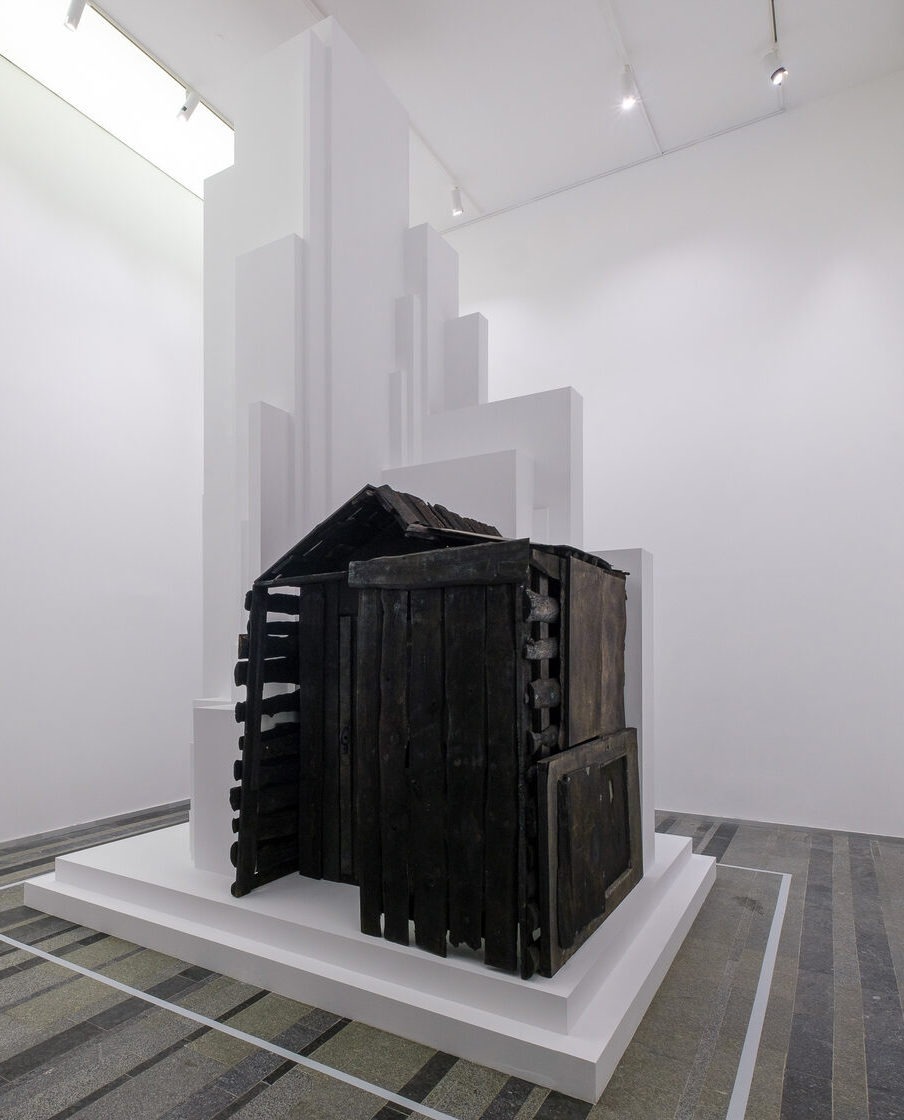
Nikita’s works were shown at the Ukrainian Pavilion of the 2015 Venice Biennale, they constantly travel to various exhibitions in all parts of Europe and last year the curators of the Paris Centre Pompidou included his work ‘Pedestal. Practice of Exclusion’ in the permanent collection of the museum. The installation consists of a huge mock-up of a pedestal that reaches up to the ceiling of the exhibition hall and a text that is written on the wall. There is no room left for the actual monument that should be mounted on the plinth. As we rewrite history, our perception of history, we seem to ignore the actual object with its corporeality, complexity, multifacetedness.
In one of his interviews, Nikita Kadan described his interest in the historiographical method in art in the following way: ‘I think the most important thing here is having courage to feel around with your hands in the dark. The dark and impenetrable character of the present seems to call for certain caution. As in, “Keep your hands to yourself, don’t poke around, something can bite your finger ‒ you don’t see what’s inside there.” An artist can base his or her work on this kind of idiot’s courage to feel around in the historical darkness. If you practice it long enough, you can develop the special sensitivity of a blind man. On the one hand, this type of action hinges on your own imprudence, your recklessness, on things that you really should not be particularly proud of. And yet, while an incoming ray of light will slowly progress, reclaiming more and more new objects from darkness, you will already know at what point these things that are now revealed by light will prove to be important. And it is not a prophecy, not a premonition; the artist here is not a medium channelling an external higher knowledge. There actually is no such higher knowledge. There is a confident indiscretion that can at some point fire and hit the bullseye of the real state of things. You were working with the subject of ‘the war of the monuments’ in Ukraine, and then suddenly the issue became visible for the rest of the world. The ray of light has travelled up to this place and will move on.’
Nikita Kadan. Sun and Satellite. 2020. Neon, metal. View of the exhibition ‘Stone Hits Stone’. Photo: PinchukArtCentre, Maksym Bilousov
Nikita has recently been very active as a curator, his efforts being directed toward highlighting the subject of the 1910s‒1930s Ukrainian avant-garde. In 2017, the ‘Postponed Futures’ exhibition in London offered an alternative take on the 20th-century Ukrainian avant-garde through the lens of contemporary Ukrainian art. This line of research was continued by Kadan’s own shows, ‘Project of Ruins’ at MUMOK in Vienna and ‘The Spectacle of Unorganized Masses’ in Ústí nad Labem in Czechia.
The exhibition nominated for the Shevchenko Prize was Nikita Kadan’s 2021 show ‘Stone Hits Stone’ at the PinchukArtCentre, a famous Kyiv art institution located at the very heart of the city (we published an extensive interview with the Centre’s Art Director Björn Geldhof in 2018). It could perhaps be said that this collection of works became a certain summary of the artists interests over the last six or seven years; once again, according to the web page on the Art Centre’s site, it featured ‘reflections on Ukrainian history, political violence, national historical heritage, avant-garde and Soviet utopia. This exhibition deals with present day challenges in its inextricable connection with the past, using history to enlighten the present and imagine the future.’
As soon as I heard about the prize, I decided that we definitely should talk. Nikita Kadan has stayed in Kyiv, a city with foreign columns of tanks on its outskirts. I called him on 12 March via the Telegram app from Riga, a city without military patrols and ‘Czech hedgehogs’ in the streets, a city where the threats following the escalation of war in Ukraine are felt particularly acutely, just like in other capitals, cities and towns of the Baltic countries. Our conversation lasted some 40 minutes or so, and when I played back the recording afterwards, it turned out that the mic of my notebook had stopped functioning normally at some point. There were terrible background noises and rustling in the recording; I had to listen to each sentence three or four times to understand what Nikita was saying. But somehow the complicated process seemed to compensate for me, if only partly, the inequality between the places from which we were communicating, the inequality I tried to express coherently at the beginning of our conversation. In the actual recording, Nikita’s voice pronounces the sentences quite slowly, pausing every now and then, conveying a sense of physical tiredness and yet, at the same time, confidently and, typically for him, in a well considered manner.
Nikita Kadan. Photo: Bert de Leenheer
You know what, this is a very strange feeling ‒ you are in Kyiv right now, surrounded by columns of tanks and whatnot, while I am talking to you from my home, from safety. A state of total asymmetry. And yet we do need to conduct this conversation, one way or another... And I wanted to ask you about the Shevchenko Prize first of all. I think it is of utmost importance that, despite the war, there is still a segment of cultural life that still goes on, no matter what. And you became a laureate of this prize...
Regarding this gap, this conversation from completely different places ‒ it is actually quite a frequent thing. There are these conversations between cultural centres and other places that are perceived as ‘periphery’. These conversations look suspicious to begin with ‒ like a kind of inequity. Whenever there is a centre and a periphery, the catastrophic experience is always expelled to the periphery.
War has been going on in Ukraine for eight years now; it did not start on 24 February. On 24 February, the Russian troops simply crossed the demarcation line and finally openly confessed to the rest of the world that it is they who are waging this war. So in a way I have grown used to these things that are happening over here. For instance, when I was interviewed in Lviv by Galya Rymby for Arterritory, there was already a war going on. And I frequently travelled to East Ukraine, I worked with history museums over there, did research for my projects. I do not feel right now that a fundamental watershed has been reached, either regarding the past or any kind of safer places. There is this fluidity of danger all the time ‒ attacks alternating with retreats, constant movement of troops around the map, war alternating with peace.
Никита Кадан. From series ‘Broken Flag Pole’, 2019–2021. Iron, print on silk fabric. View of the exhibition ‘Stone Hits Stone’. Photo: PinchukArtCentre, Maksym Bilousov 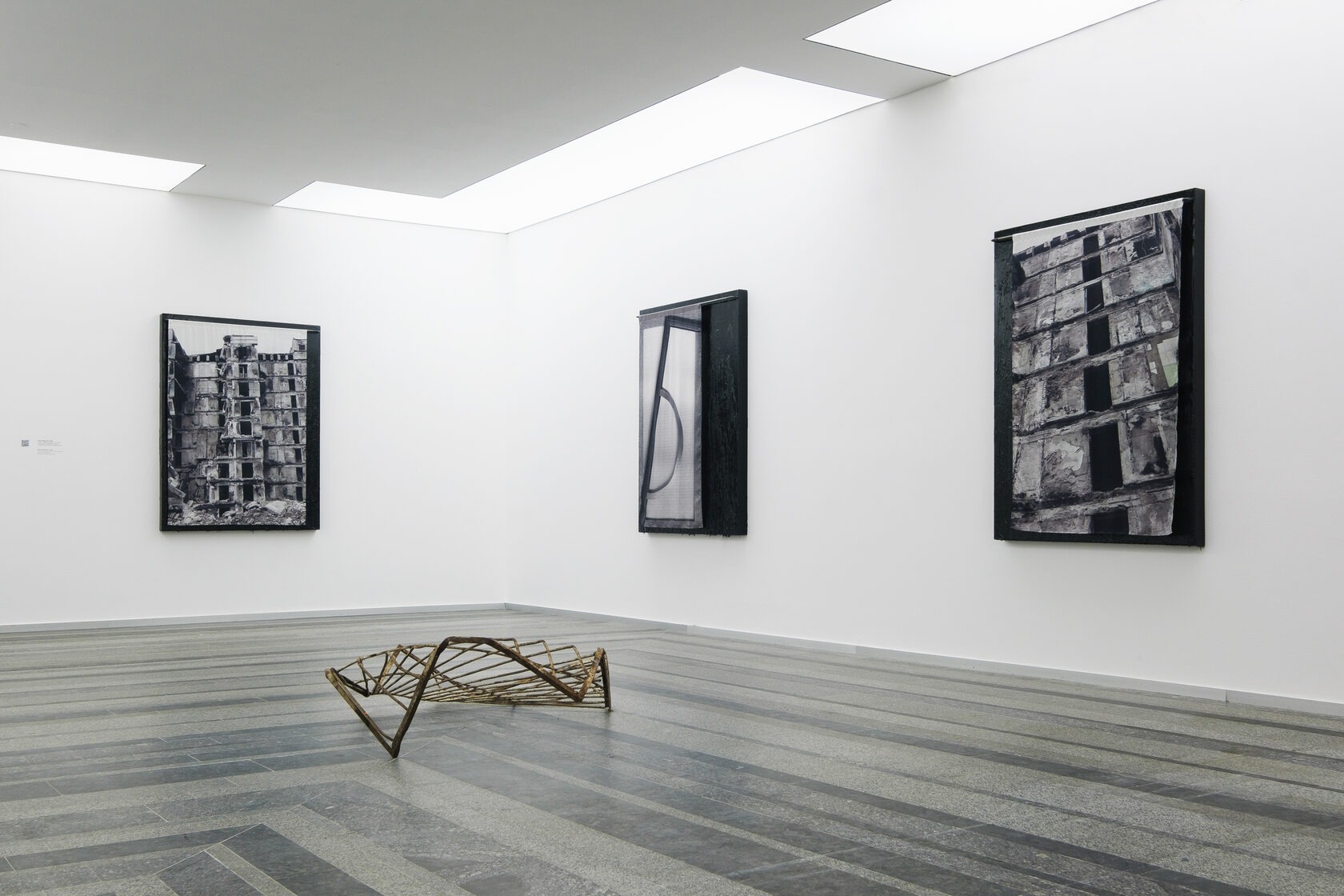
Still, this is a very acute phase... As we speak, the Russian forces are 25 km from Kyiv. It is a fact that seems to loom large in your mind... At least it does in mine.
Yes, I understand. Perhaps it’s because everybody has grown used to thinking about kyiv as a peaceful place, unlike the cities of Eastern Ukraine. Although they, too, used to be ordinary peaceful cities up until 2014…
Regarding the prize ‒ it is a sign that life has not as yet completely transformed into survival. That certain cultural rituals are still being performed. It is actually perhaps a watershed between life and a regime of pure self-preservation, preservation of your body. During these two weeks, I have been spending most of my time at a gallery that has been converted into a bomb shelter. It is the Voloshyn Gallery; this basement space actually used to be a bomb shelter in the past, during the Soviet times. I sleep over there; I also mounted a small group exhibition from the collection of the gallery, featuring classics of Ukrainian modernism like David Burliuk or the 1970s non-conformists, for instance, Konstantin-Vadim Ignatov, also contemporary artists. And this exhibition is also a way of holding on to something peace-related in your life ‒ to culture as something that you can actually afford to embrace.
Is the show open during the day ‒ can people access it?
The exhibition is displayed in the rooms; the works are simply propped up against the walls. And some people do visit them and are able to view the show. The gallery does not have normal opening hours, of course; people live there right now. But those who really want to see it ‒ they can access it.
What about the prize, though? Was there a ceremony or did they simply notify you of winning it?
Yes, I was simply told that I had won it. The truth is, I wanted to use the money at once to help some war-time humanitarian causes that have to do with life in a city under siege. But later that night, Zelenskiy during his ‘address to the nation’ mentioned that the prize would be presented after the victory of Ukraine. I suspect that it also concerns the monetary aspect of the prize.
I think there will be more than enough humanitarian causes needing support after the war...
I’m sure I will be able to find some.
You won the prize for your 2021 exhibition ‘Stone Hits Stone’ at PinchukArtCentre. It was an extensive project that covered a range of subjects, and yet a lot of that had to do with violence in the history. And perhaps an attempt to take a neutral look at it ‒ one that is more human than ideological.
It is first and foremost a materialistic look. ‘Human’ is something that seems, on the one hand, too extensive and general; on the other hand, it is a reference to ‘humanity’, to a humane and somewhat sentimental approach.
I think that my outlook is a materialistic one, and a poetic one at the same time. The poetics of matter, the becoming of it. Incidentally, in this exhibition, the various materials, forms and surface textures dominate over the pictures, the images. The human images, first of all. It is mostly iron, stone, plasterboard, wood, coal, silk, resin, marble. The fact that these are images of figures is only secondary. And they are also mediated through a certain feel of corporeality and texture, through old photographs. Through archive photographs that I introduce into my work, reproducing them in the pictures in coal or Indian ink or showing the archive images as found objects.
Nikita Kadan. Pogrom. 2016. Charcoal on paper. View of the exhibition ‘Stone Hits Stone’. Photo: PinchukArtCentre, Maksym Bilousov 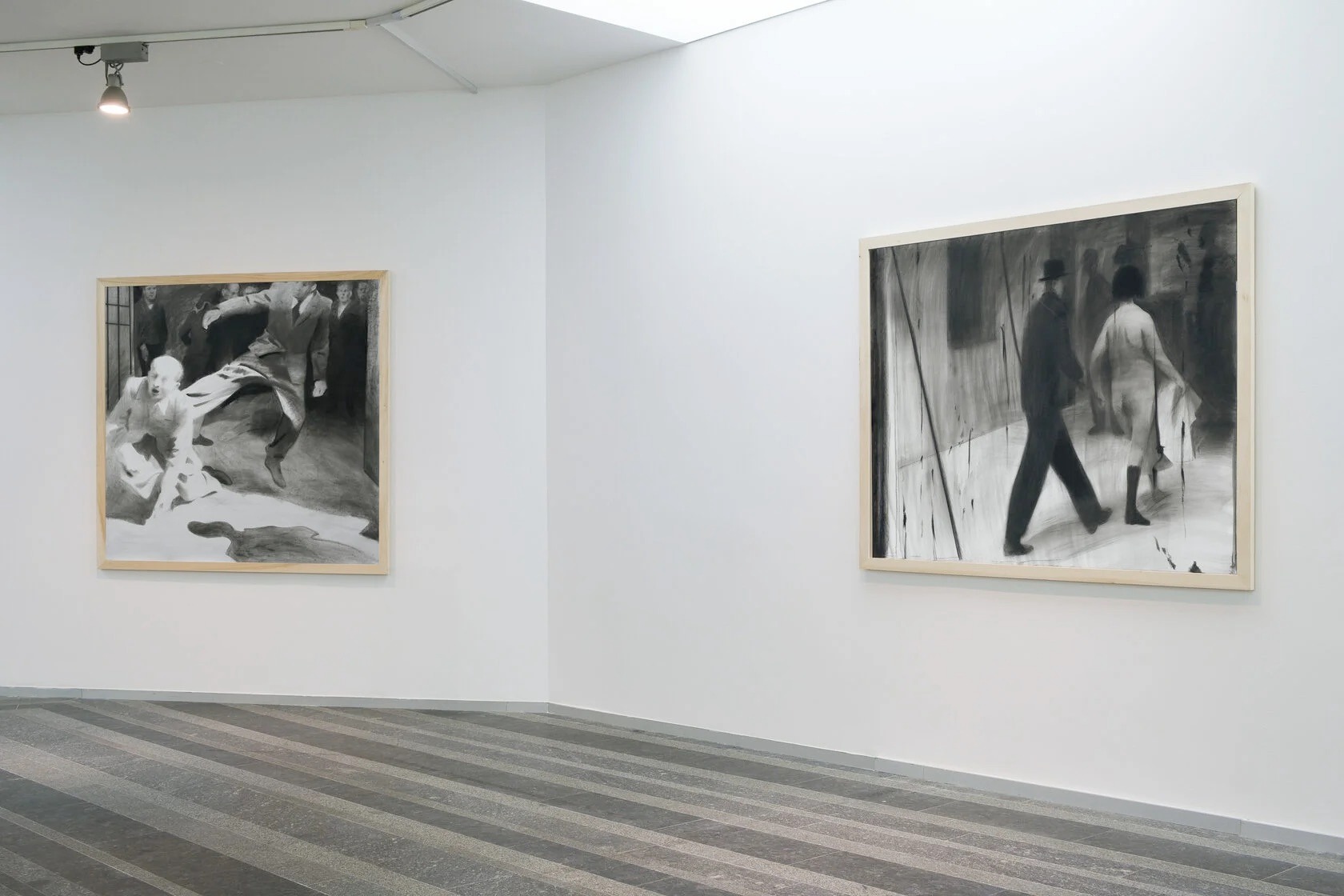
And yet the subject of violence is quite present there, particularly in the images that have to do with the Lviv pogrom or the events in Volyn.
I once wrote a text on the need to measure art in execution pits. The text still works for me as a kind of manifesto.
But what are your thoughts ‒ how can an artist exist and work at a time when an ultra-strong surge of violence is taking place this very moment? Missiles and shells are falling on hospitals and homes, cars with people who try to evacuate their loved ones are being fired at...
I will say again that for me there is no fundamental difference between the things that are going on right now and the events that unfolded in the recent years in East Ukraine. And the fact that the war has spilled over to the west and come to visit me ‒ well, before that, I used to pay it regular visits in the eastern part of the country. I remember the completely bomb-riddled ruins of Vuhlehirsk (Uglegorsk); I remember Debaltseve where most streets in the city centre were crippled by shell fragments. It was in autumn 2014. There is intense fighting going on right now in this part of Ukraine but it has shifted beyond the demarcation line ‒ to Sievierodonetsk, to Lysychansk.
I continue to work although I am severely limited in it materially and physically. As often as not, I have some paper, coal and my iPhone camera. But on the whole, I make things in pretty much the same key as before. Of course, this experience of siege, this ever-approaching frontline ‒ they do have an effect but perhaps mostly on the material side of things. I mean, there is no way I can buy some paper right now. It has a greater impact than any kind of specific anxiety, any emotional aspects.
Nikita Kadan. From series ‘The shadow on the ground‘. 2022. Charcoal on paper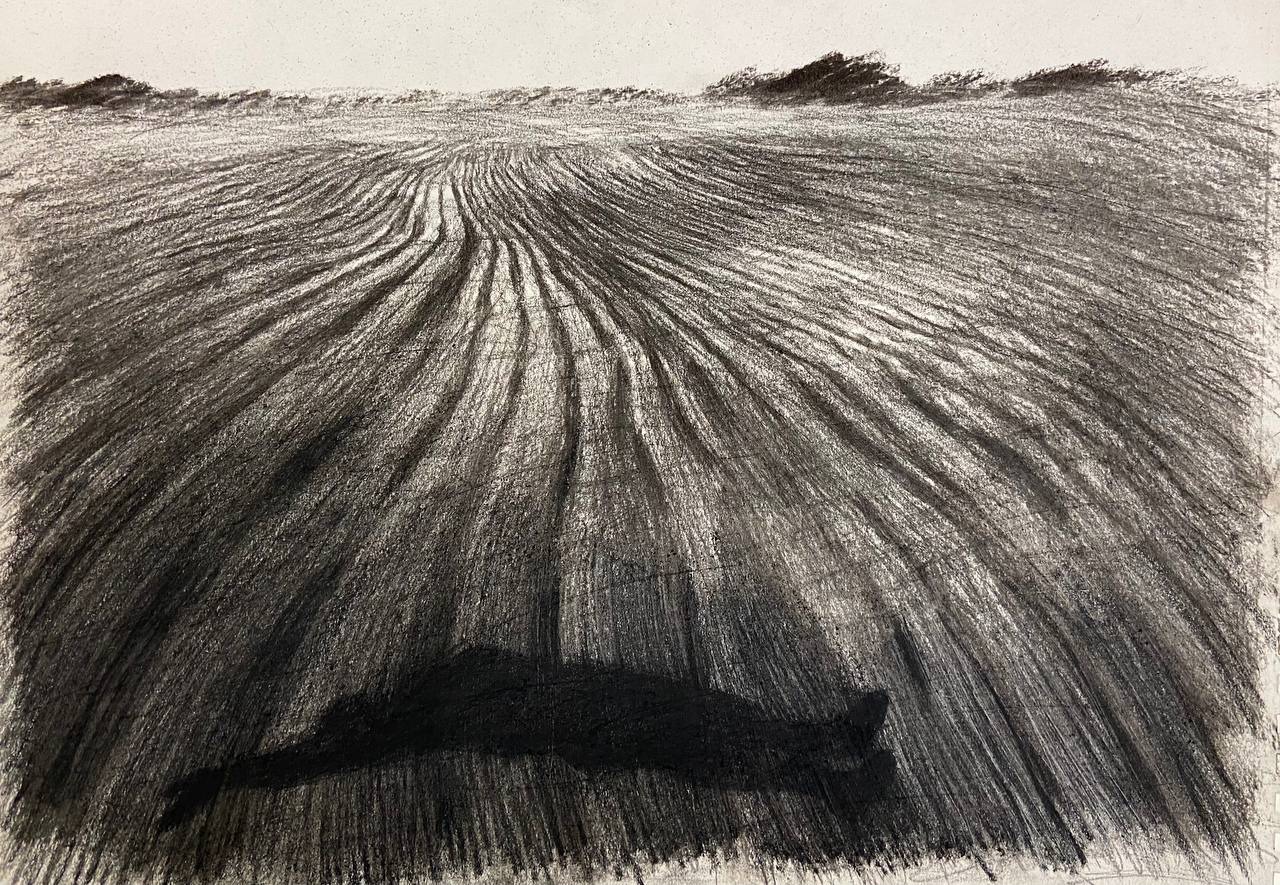
What about your friends and acquaintances, other Kyiv artists? Do you try to survive this situation together or is it perhaps not really possible?
Some of the artists have left for the western part of the country, others stay in Kyiv. Artist Katya Libkind, for instance, works as a volunteer at a psychiatric hospital. Many ‒ although it is, of course, only female artists who are able to do that ‒ have left for the West. As for myself, I draw, I also curate exhibitions in the basement and curate exhibitions elsewhere in the world from my basement.
What are these exhibitions?
Well, ‘A Letter from the Front’, to name one, a joint project that was just shown at Castello di Rivoli in Turin and will be shown at Moderna Museet, the Stockholm museum of contemporary art in a week’s time. It is a selection of Ukrainian video works that can, or so I believe, tell something important about the experience of this part of the world; the narrative is, I think, quite strong and cohesive.
On the whole, people are coping with the current state of affairs in one way or another. A work of art, of course, mostly demands time to be created, and so the whole picture will only become obvious later ‒ who is doing what in connection with the current events. Right now, the works of Vlada Ralko and Ekaterina Lisovenko stand out. They both paint very quickly responding to the things that are going on and post their pictures on social media. It is all very visible and very timely.
Do you sense a kind of general mood in the city ‒ to what extent this situation has united people from different circles, people with different outlooks?
The city lives under a very strict regime, a strict rhythm. The streets are almost empty. There is a curfew; people mostly leave home to attend to a serious necessity; besides, many have left Kyiv. But garbage is collected, there is bread in baker’s shops, traffic lights are working again ‒ during the first few days, the streets were completely empty and the traffic lights did not work. Territorial defence force patrols in many parts of the city centre; if they see you taking pictures with your phone, they may approach you and check you.
But do people talk among themselves, do they discuss the events?
Yes. Of course, we haven’t gone back to the old tradition of speaking to people in the street: the social media have not disappeared, after all. But nevertheless, social links have become stronger. There is indeed more mutual attention and recognition. Neighbours have started greeting each other. During the day, everybody is mostly busy with tasks that are relevant to survival. But like I said, there are signs of actual life going on, a presence of cultural rituals.
Before this intensification of war, there was quite a noticeable and dynamic discourse of confrontation between, say, queer/feminist ideas and right-wing ones, conservative and patriarchal. Apparently, this confrontation is no longer acutely important under the present circumstances...
I have not noticed any rivalry between the left and the right in Ukraine. The domain that is known as professional politics was actually completely lacking the left wing of the spectrum. The left part was occupied by political forces that are known as centrist in the West. Speaking of micro-political communities, of the political meaning of art and culture, there was this confrontation, of course. The right attacked all sorts of queer/feminist events or scientific meetings and talks dedicated to analysis of nationalism. Basically, there was this fight going on of the ultra-right against critical culture and against diversity of identities and lifestyles. On the other hand, while there was a complete absence of leftist parties, the ultra-right also did not manage to get into the Rada ‒ neither in 2014 nor later. The golden age for the ultra-right in the Ukrainian parliament was in Yanukovych’s time when the Svoboda party was used as a ‘pocket enemy’, as a bogey for the electorate. But after Maidan, Svoboda did not get into the Rada, and it has not managed to do it to date.
On the whole, Ukrainian politics does not fit the model of ideological competition very well. It is more about various clans and groups; they do sit on a certain spectrum, of course, but it is not a spectrum between the right and the left but rather between the pro-Western and pro-Russian forces.
Nikita Kadan. Anonymous. Tarred. 2021. Marble, wood, paint, tar. View of the exhibition ‘Stone Hits Stone’. Photo: PinchukArtCentre, Maksym Bilousov 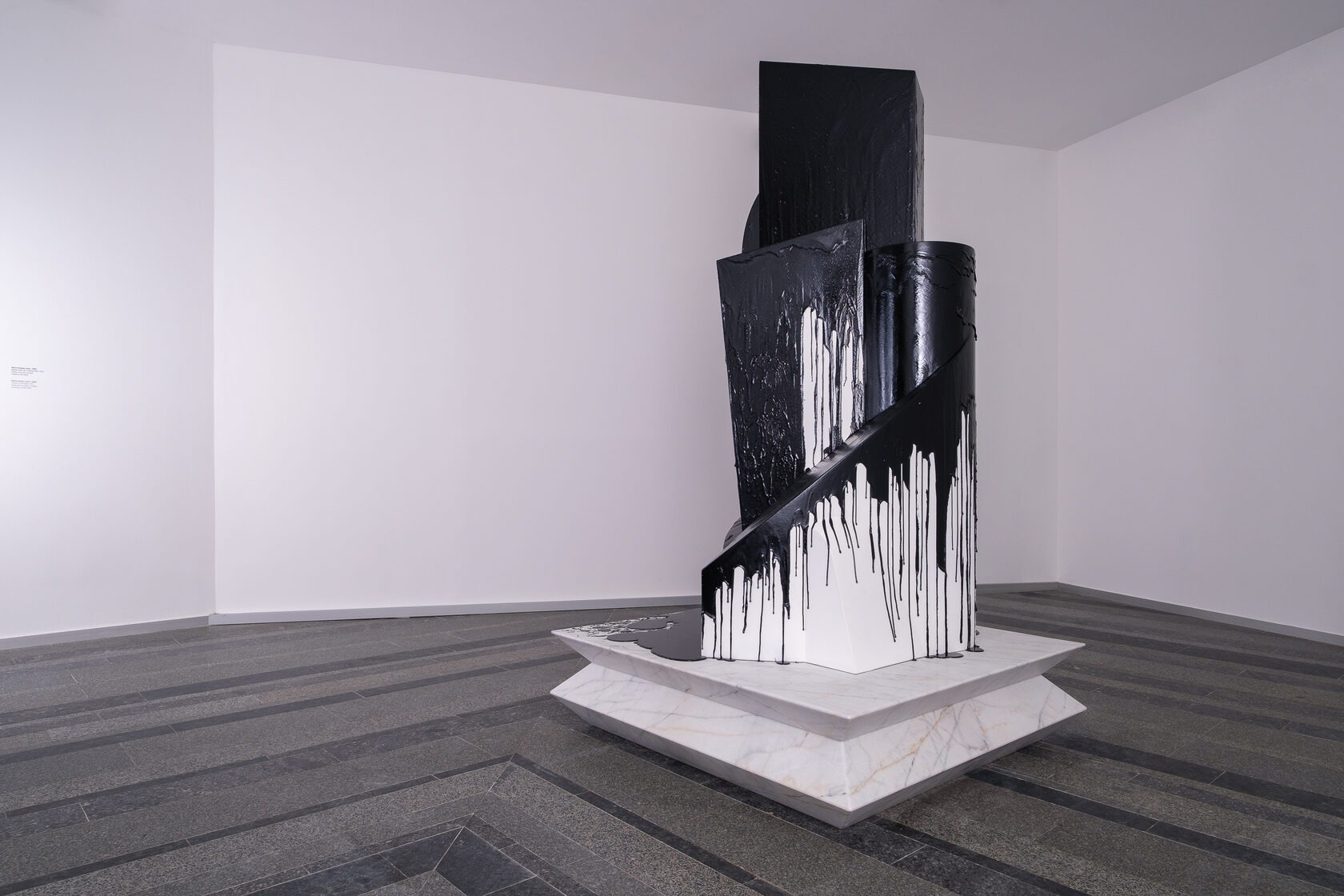
I understand, of course, that making any predictions is a thankless task. And yet ‒ do you think that this order of things will change after the war? What will be the impact of the current unity of the Ukrainian society with its powerful reaction to the aggression on the situation?
I don’t know. The unity we found early in 2014 was spent quite quickly. There is this presence of an external impulse, of course, that makes us come together right now. In a more powerful way than back in 2014. But even that does not give us any guarantees. The thing is, polarisation and political confrontation would be productive if there was a possibility of polemics, if there was a political language as such. But the language and its system of terms has been completely devaluated. Throughout the post-Soviet years and for a huge part of the Soviet era, the political vocabulary was abused in every possible way; words were assigned new meanings depending on the needs of the day, on momentary interests. And now certain terms have stopped being terms. For instance, the word ‘fascism’ has lost its specific political meaning, its own political tradition. ‘Fascists’ now are simply the enemy side, essential evil. There are ‘our people’, and then there are ‘the Germans’. That is the order of things in the world, and no explanations are necessary.
Will a politics come afterwards that has a connection with the language and clear-cut structures of ideas and positions? Nobody has predicted that as yet. There is this external enemy, and we define ourselves against it. The political spectrum in Ukraine is currently defined by the Russian aggression. It shapes the political life in Ukraine. Meaning that any disagreement between the pro-Zelenskiy camp and the pro-Poroshenko camp belong to the past right now. We are in the same boat now, or inside the same burning building. Once we extinguish the fire, the conflicts will come back. But I am not sure that they will come back on some kind of a new level of political culture. But perhaps things will be viewed in a more realistic way after these huge losses, this huge bloodshed.
Nikita Kadan. The Spectators., 2016. Charcoal on paper. View of the exhibition ‘Stone Hits Stone’. Photo: PinchukArtCentre, Maksym Bilousov 
Could you tell me your opinion of the reaction to war (or lack thereof) among the members of the Russian art scene?
I am currently not following the Russian art scene particularly closely. I am more concerned about the movements of the Russian troops, to be honest. But among the things that I have noticed ‒ Party of the Dead have made some very powerful statements.
There is also some deliberate disregarding of subtle and complex multifaceted art practices going on. I know that the artist Alexandra Sukhareva declined the invitation to show at the Russian Pavilion in the Venice Biennale, which amounted to practically closing it completely. Another participating artist, Kirill Savchenkov, also declined, as did the curator. It was only then that the Biennale closed the Russian Pavilion as a sign of its protest against the war. But at the time of closing the pavilion was already empty; it had been left by the artists who were supposed to show there. Alexandra Sukhareva is a very sophisticated contemporary artist. But her gesture had nothing to do with the content of her art. Deep and multi-layered things like hers automatically transfer to the silent mode these days ‒ because they have different levels of sound volume, different wavelengths of perception.
And I also see that part of Russian intellectuals are now in a state of confusion and indecision. Because, on the one hand, the significant base of resources that they were able to enjoy ‒ meaning first and foremost the Moscow scene ‒ has now disappeared. On the other hand, they had already managed to claim a relatively high rank on the international scene over the recent years. And there are serious efforts to exclude the Russian culture from the global processes going on now, at varying degrees of generalisation. There are some places where they speak about Russian culture in general; elsewhere, it is about institutions linked to the Russian government or Russian corporate money. Sometimes there is a distinction made between artists who support the Russian government and those who oppose its actions; in other cases, they are all treated as a whole. So many contradictory and somewhat spontaneous decisions are being made regarding these matters.
In this context, Western institutions are generally attempting to hold on to the values that are universal openness and dialogue, although these values are starting to sound somewhat abstract against the backdrop of the Russian aggression ‒ there is too little that connects them with the specifics of the present day. Others are opting for an outright ban ‒ but without a clearly defined position as to what it is that they are banning. It’s just about one Russian speaker or another situationally losing their access to publicity.
And ultimately, against the background of all this, it is very difficult to phrase a statement that would also contain other layers that have nothing to do with the demands of the moment. There is a situation of urgency going on where expressing yourself in long sentences is too great a luxury.
Nikita Kadan. From series ‘The shadow on the ground‘. 2022. Charcoal on paper
But tell me please ‒ the Ukrainian pavilion in Venice, can it even happen? What is the situation regarding the project?
The Venice Biennale made it known that they will help to make it happen. Which means that, provided that the artist Pavlo Makov, as well as other people from the pavilion team, will be given permission to leave for Venice, they will probably be able to get something done. (According to the update provided on 14.03.22 by the curator of the Ukrainian Pavilion at the Venice Biennale Elizaveta German, the artist Pavlo Makov is already in Vienna and is prepared to attend the opening of the Venice Biennale ‒ Auth.)
Do you think the project, entitled ‘Fountain of Exhaustion. Acqua Alta’ can create a resonance at this time over there?
The question is, of course, which levels of the project will create a resonance. The Ukrainian pavilion will draw a lot of attention, no matter what they show. Makov is a relatively conservative artist, a bit of an ‘antique’ even ‒ a kind of poetic quasi-archaeology. Over the years, the Ukrainian Pavilion has showcased lots of diverse projects that have had various degrees of connection with contemporaneity. This is a case where what you do best is lulling whispers but history puts a loudspeaker in your hand. I think that the show will be noticed ‒ in one way or another.
Anyway, the question remains ‒ what does it mean to resonate today? Does it imply that the actual fact of you speaking has been noticed or the content of what you had to say? The recognition of the fact that there is art in Ukraine has taken place. And it goes hand in hand with the recognition that there is Ukraine itself and that a catastrophe is unfolding there. The goal is now to move from the bare recognition of the catastrophe to explanation of its logic ‒ and from thereon, to predicting the perhaps fantastic ways in which life will inevitably prevail.